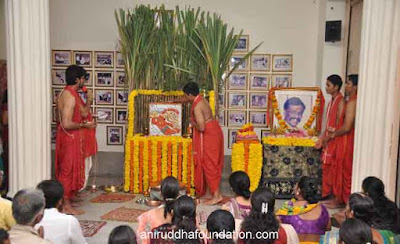The ‘Ashwattha Maruti Poojan’ is conducted sequentially, starting with the preparatory poojan arrangement, the main ceremonial rites then followed by the darshan.
Behind the stone sculpture of Hanumant carved by Shree Aniruddha, a branch of the Peepal tree (the Ashwattha tree) is placed as a symbol. A fine metallic idol of Hanumant is placed in a copper salver before the sculpture. At the backdrop is placed an overlay of sugarcanes against the arrangement and decorations. A group of Prapathak(s)(religious reciters) is tasked with a continuous, uninterrupted recital.
At first, the Ashwattha (Peepal) branch is worshipped in the vedic manner, by chanting the mantras of ‘Om Ashwatthaaya Namah | Om Urdhvamukhaaya Namah | Om Vanaspataye Namah |. It is then ‘followed by the offering of Naivaidya (consecrated food). The idol of Hanumant is then worshipped by performing the Shodasha Upchara Poojan (16-step rituals for worship). At the time, the ‘Panchamukha Hanumat Kavach’, ‘Sankat Mochan Hanuman Stotra’, and ‘Om Shree Ramdutaay Hanumantaay Mahapranaay Mahabalaay Namo Namah |’ are chanted 54 times.
Five shraddhavan bachelors are asked to offer the ‘shendoor’ (saffron coloured powder) and ‘lahya’ (popped rice grain), while an abhishek (an ointment with water) is performed on the idol of Lord Hanumant, resting on the copper plate by a pre-designated couple. Simultaneously, another abhishek is also performed on the idol of Shree Panchamukh Hanumant. The facility to perform a symbolic abhishek on a beetle nut is also available for the shraddhavans who so desire. Every shraddhavan gets the opportunity to apply the shendoor over the Hanuman idol while taking its darshan. The pooja ceremony draws to a close with the poornaahuti (final offering) and a final recitation of the ‘Bhimarupi Maharudra’ stotra.
Anjani Mata is Shree Hanumant's mother and as a symbol of her presence, the Dhuni Mata is constructed and worshipped before the idol of Shree Hanumant. The dhuni (sacred fire) ignited in honour of Dhuni Mata, is offered lahya, camphor and samidha(twigs of wood used as sacred offering in rituals). The Dhuni Mata is also offered turmeric powder and kunku (red vermilion powder) as a part of the Oti (ritual for Hindu women). The Dhuni Mata is laid to rest later, at night. The Pooja celebration then concludes with the recital of the Ramraksha, Hanuman Chalisa and Aniruddha Chalisa.


No comments:
Post a Comment